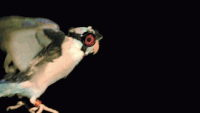It looks like you're using an Ad Blocker.
Please white-list or disable AboveTopSecret.com in your ad-blocking tool.
Thank you.
Some features of ATS will be disabled while you continue to use an ad-blocker.
23
share:
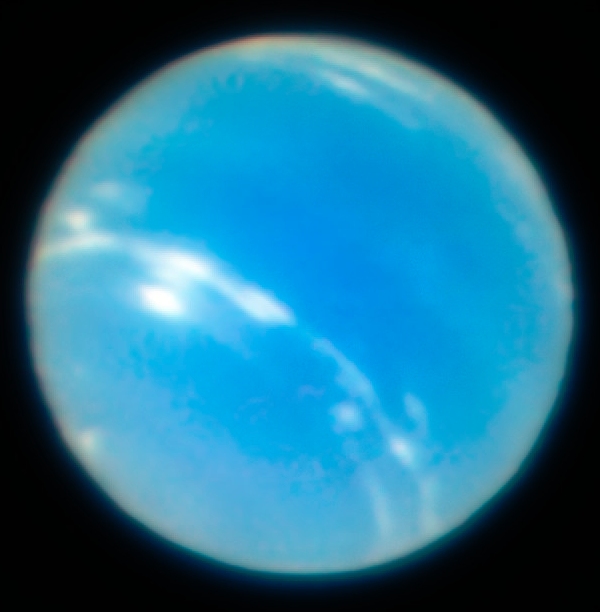
European Southern Observatory's (ESO) Very Large Telescope (VLT) has a new adaptive optics mode, which now allows them to get better and sharper images than the Hubble!
www.eso.org...
ESO’s Very Large Telescope (VLT) has achieved first light with a new adaptive optics mode called laser tomography — and has captured remarkably sharp test images of the planet Neptune, star clusters and other objects. The pioneering MUSE instrument in Narrow-Field Mode, working with the GALACSI adaptive optics module, can now use this new technique to correct for turbulence at different altitudes in the atmosphere. It is now possible to capture images from the ground at visible wavelengths that are sharper than those from the NASA/ESA Hubble Space Telescope. The combination of exquisite image sharpness and the spectroscopic capabilities of MUSE will enable astronomers to study the properties of astronomical objects in much greater detail than was possible before.
At the top of this post is their new image of Neptune, compare it with the Hubble's image:
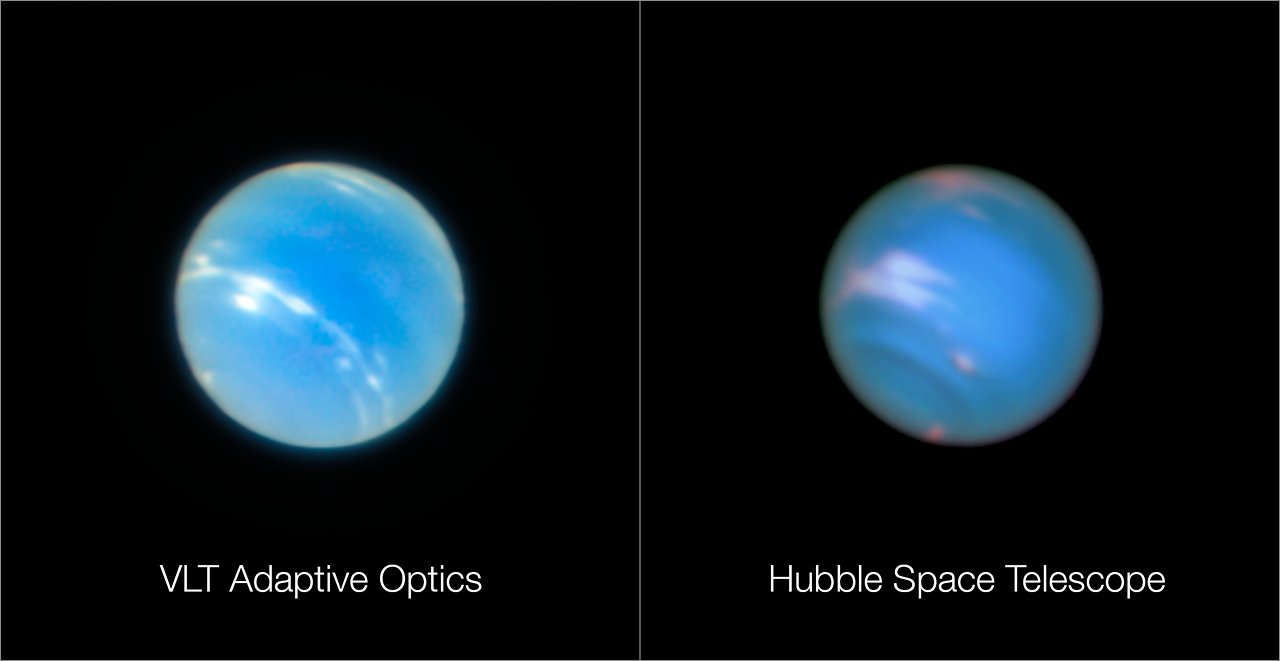
Thing is, VLT is 4 times larger than the Hubble, but due to being located on earth it has to deal with lots of atmospheric turbulence, which makes space images blurry. Adaptive optics systems are a real game changer here, using artificial "laser guide stars" to compensate for those turbulences.
Compare the new image with the one taken without using the adaptive optics:
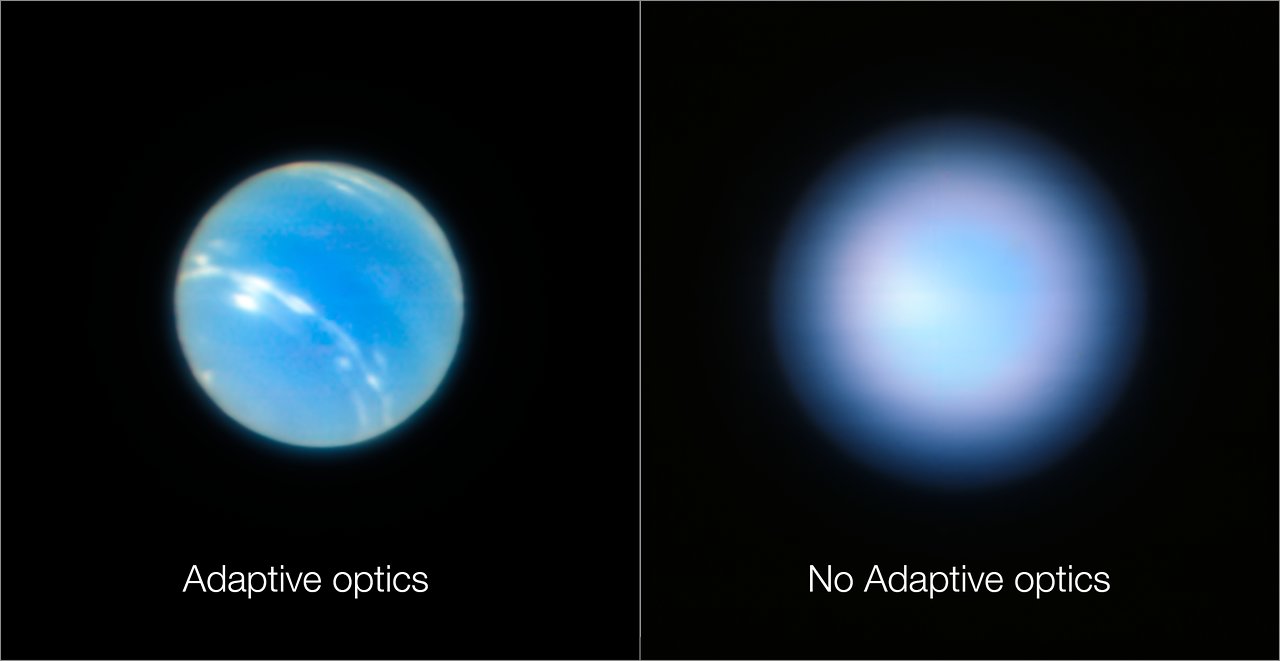
Wow, what a difference does it make!
To achieve this, the observatory blasts four powerful lasers into the sky, in order to create artificial stars and monitor how they're distorted by atmospheric turbulences:
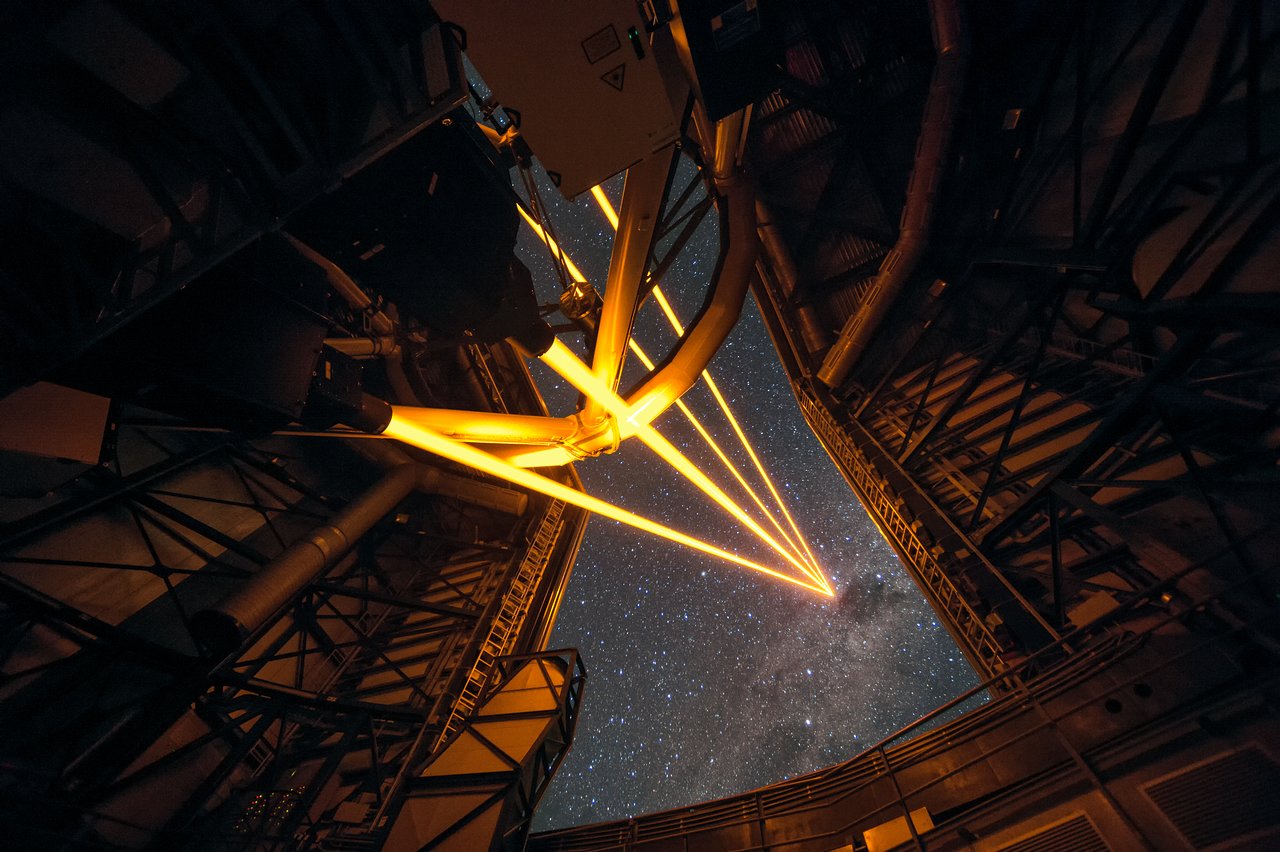
Cool video:
www.youtube.com...
edit on 29-7-2018 by wildespace because: (no reason given)
a reply to: wildespace
WoW that’s amazing that they achieved that with a ground based telescope! I can’t wait to see some other objects.
WoW that’s amazing that they achieved that with a ground based telescope! I can’t wait to see some other objects.
a reply to: Alien Abduct
They also published this comparison image of a star cluster:

Middle inset: without adaptive optics, inset on the right: with adaptive optics.
www.youtube.com...
They also published this comparison image of a star cluster:

Middle inset: without adaptive optics, inset on the right: with adaptive optics.
www.youtube.com...
a reply to: wildespace
Clever guys. It's wonderful what these scientists do and thank God they have the funding to push back the boundaries. The VLT could change our way of looking at the universe like the Hubble did. It was only recently when they published an image of a planet at the beginning of its life. I'm looking forward to the new images and their ingenious fine tuning.
To achieve this, the observatory blasts four powerful lasers into the sky, in order to create artificial stars and monitor how they're distorted by atmospheric turbulences:
Clever guys. It's wonderful what these scientists do and thank God they have the funding to push back the boundaries. The VLT could change our way of looking at the universe like the Hubble did. It was only recently when they published an image of a planet at the beginning of its life. I'm looking forward to the new images and their ingenious fine tuning.
a reply to: Kandinsky
I can't wait for when ESO's Extremely Large Telescope goes into service. It will have a primary mirror of nearly 40 meters in diameter (The Hubble's is only 2 m, and VLT's 8 m). It will already exceed Hubble's resolution, but with this new mode of adaptive optics, the results would be unimaginably better. Since this new mode practically removes any atmospheric influence, it would be like having a 40-meter space telescope!
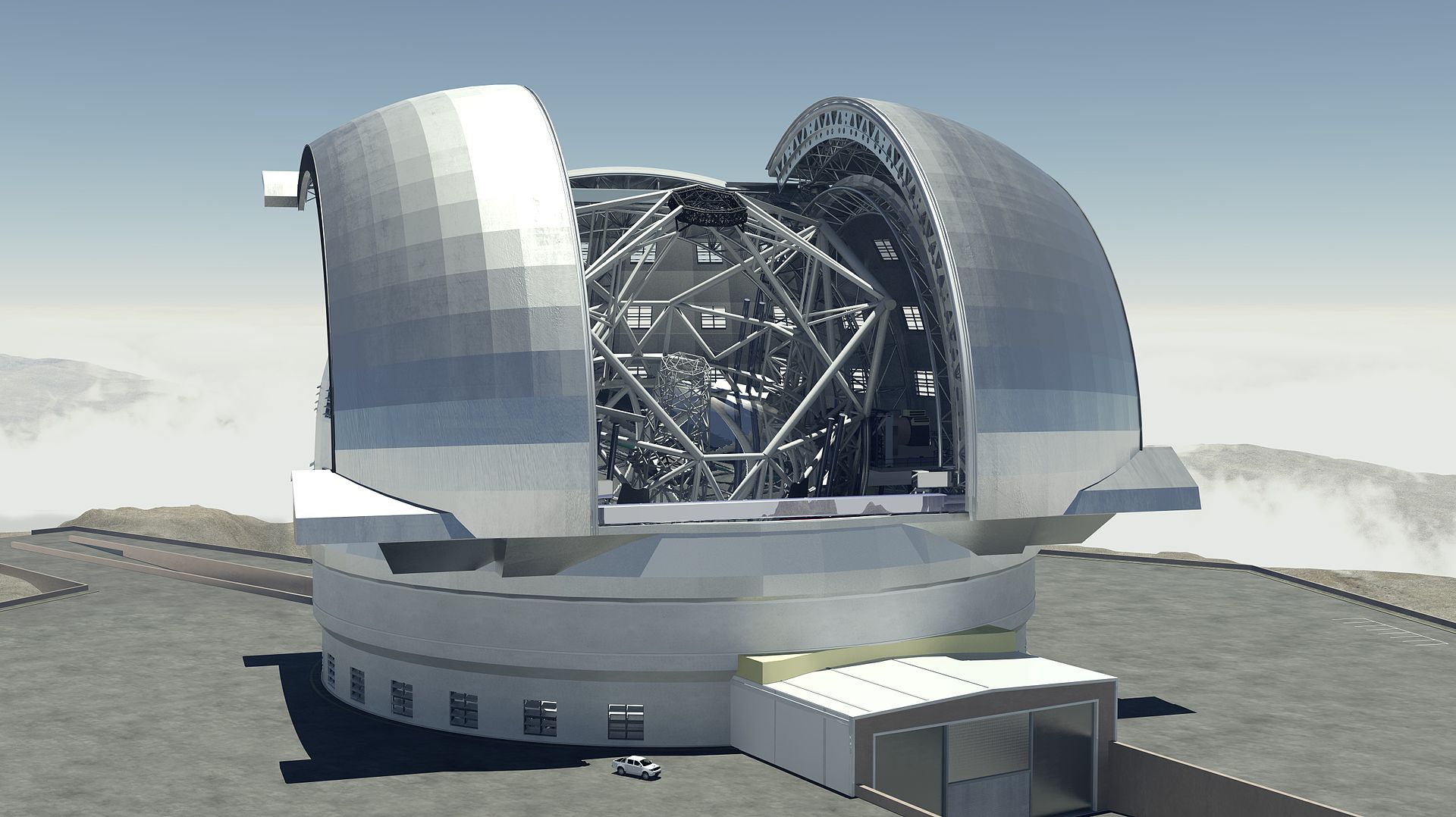
I can't wait for when ESO's Extremely Large Telescope goes into service. It will have a primary mirror of nearly 40 meters in diameter (The Hubble's is only 2 m, and VLT's 8 m). It will already exceed Hubble's resolution, but with this new mode of adaptive optics, the results would be unimaginably better. Since this new mode practically removes any atmospheric influence, it would be like having a 40-meter space telescope!

a reply to: wildespace
Thanks for those extra tidbits, I am just stunned! I love this! That video is friggin jaw dropping it really puts it into perspective. Just fascinating S&F
Thanks for those extra tidbits, I am just stunned! I love this! That video is friggin jaw dropping it really puts it into perspective. Just fascinating S&F
edit on 7/29/2018 by Alien Abduct because: (no reason given)
a reply to: wildespace
It makes the mouth water, doesn't it? I was just reading around their achievements and wondering if they'll be doing any 'signs of life' searches? Imagine when the James Webb is fully active and something like this ELT in tandem? Will the ELT be used for similar pursuits?
It makes the mouth water, doesn't it? I was just reading around their achievements and wondering if they'll be doing any 'signs of life' searches? Imagine when the James Webb is fully active and something like this ELT in tandem? Will the ELT be used for similar pursuits?
a reply to: wildespace
Hubble's an old girl now so no surprise technology is passing her by , nice to see ESO making advancements in ground based technology and getting results that exceed space based options given the failure by NASA to get JWST off the ground.
+1 Europe.
Hubble's an old girl now so no surprise technology is passing her by , nice to see ESO making advancements in ground based technology and getting results that exceed space based options given the failure by NASA to get JWST off the ground.
+1 Europe.
originally posted by: Kandinsky
a reply to: wildespace
It makes the mouth water, doesn't it? I was just reading around their achievements and wondering if they'll be doing any 'signs of life' searches? Imagine when the James Webb is fully active and something like this ELT in tandem? Will the ELT be used for similar pursuits?
Both the Webb and ELT will be studying exoplanets and their properties. Whether that will help us in our search for "signs on life", I don't know. www.eso.org...
a reply to: wildespace
I saw the ESO have done work (years ago) analysing the composition of space within galaxies. It made me wonder if this new level of accuracy will aid the refraction of exoplanetary atmospheres for signs of life. Not just production of heavy metals associated with technology, but mainly for signals of Cambrian explosions and so forth. Yeah, I know these may well be very, very rare, but more likely than technologies.
Any/every technological world will have passed through some kind of atmospheric process towards being habitable. Based on our sample of one (lol), we can expect the process of oxygenating an atmosphere to occupy a larger period of time than developing technology or smelting metals. Looking for Goldilocks atmospheres could be a lot of fun.
I saw the ESO have done work (years ago) analysing the composition of space within galaxies. It made me wonder if this new level of accuracy will aid the refraction of exoplanetary atmospheres for signs of life. Not just production of heavy metals associated with technology, but mainly for signals of Cambrian explosions and so forth. Yeah, I know these may well be very, very rare, but more likely than technologies.
Any/every technological world will have passed through some kind of atmospheric process towards being habitable. Based on our sample of one (lol), we can expect the process of oxygenating an atmosphere to occupy a larger period of time than developing technology or smelting metals. Looking for Goldilocks atmospheres could be a lot of fun.
originally posted by: moebius
a reply to: wildespace
There you have it. Everything is better with frickin laser beams.
Dr. Evil knows best.
a reply to: wildespace
Those are some very sexy images-i feel like playing some Barry White while slow dancing with my telescope.
Those are some very sexy images-i feel like playing some Barry White while slow dancing with my telescope.
new topics
-
BIDEN Admin Begins Planning For January 2025 Transition to a New President - Today is 4.26.2024.
2024 Elections: 2 hours ago -
Big Storms
Fragile Earth: 4 hours ago -
Where should Trump hold his next rally
2024 Elections: 7 hours ago -
Shocking Number of Voters are Open to Committing Election Fraud
US Political Madness: 7 hours ago -
Gov Kristi Noem Shot and Killed "Less Than Worthless Dog" and a 'Smelly Goat
2024 Elections: 8 hours ago -
Falkville Robot-Man
Aliens and UFOs: 8 hours ago -
James O’Keefe: I have evidence that exposes the CIA, and it’s on camera.
Whistle Blowers and Leaked Documents: 9 hours ago -
Australian PM says the quiet part out loud - "free speech is a threat to democratic dicourse"...?!
New World Order: 10 hours ago -
Ireland VS Globalists
Social Issues and Civil Unrest: 10 hours ago -
Biden "Happy To Debate Trump"
2024 Elections: 11 hours ago
top topics
-
James O’Keefe: I have evidence that exposes the CIA, and it’s on camera.
Whistle Blowers and Leaked Documents: 9 hours ago, 17 flags -
Australian PM says the quiet part out loud - "free speech is a threat to democratic dicourse"...?!
New World Order: 10 hours ago, 15 flags -
Blast from the past: ATS Review Podcast, 2006: With All Three Amigos
Member PODcasts: 13 hours ago, 13 flags -
Biden "Happy To Debate Trump"
2024 Elections: 11 hours ago, 13 flags -
Ireland VS Globalists
Social Issues and Civil Unrest: 10 hours ago, 9 flags -
Mike Pinder The Moody Blues R.I.P.
Music: 13 hours ago, 8 flags -
Shocking Number of Voters are Open to Committing Election Fraud
US Political Madness: 7 hours ago, 6 flags -
BIDEN Admin Begins Planning For January 2025 Transition to a New President - Today is 4.26.2024.
2024 Elections: 2 hours ago, 6 flags -
What is the white pill?
Philosophy and Metaphysics: 12 hours ago, 6 flags -
RAAF airbase in Roswell, New Mexico is on fire
Aliens and UFOs: 11 hours ago, 5 flags
active topics
-
BIDEN Admin Begins Planning For January 2025 Transition to a New President - Today is 4.26.2024.
2024 Elections • 15 • : theatreboy -
RAAF airbase in Roswell, New Mexico is on fire
Aliens and UFOs • 12 • : pianopraze -
A Warning to America: 25 Ways the US is Being Destroyed
New World Order • 29 • : 19Bones79 -
Big Storms
Fragile Earth • 15 • : Caver78 -
What is the white pill?
Philosophy and Metaphysics • 22 • : AlexandrosOMegas -
University of Texas Instantly Shuts Down Anti Israel Protests
Education and Media • 315 • : CriticalStinker -
Gov Kristi Noem Shot and Killed "Less Than Worthless Dog" and a 'Smelly Goat
2024 Elections • 58 • : cherokeetroy -
Biden "Happy To Debate Trump"
2024 Elections • 51 • : rickymouse -
Hate makes for strange bedfellows
US Political Madness • 53 • : 19Bones79 -
SETI chief says US has no evidence for alien technology. 'And we never have'
Aliens and UFOs • 79 • : SchrodingersRat
23

